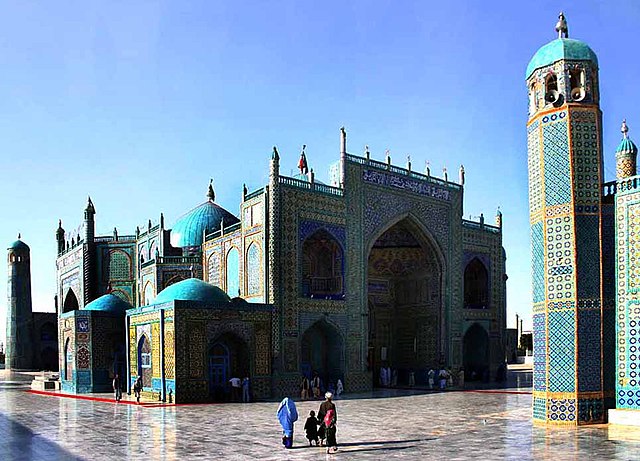Loading AI tools
Venerated structure in traditional Islam From Wikipedia, the free encyclopedia
A mazār (Arabic: مَزَار), also transliterated as mazaar, also known as marqad (مَرْقَد) or in the Maghreb as ḍarīḥ (ضَرِيْح), is a mausoleum or shrine in some places of the world, typically that of a saint or notable religious leader. Medieval Arabic texts may also use the words mašhad (مَشْهَد) or maqām to denote the same concept.[1]
This article appears to be a dictionary definition. (October 2023) |




Practices vary considerably in different countries. Syncretism is not unusual, where pre-Islamic practices and beliefs persist among Muslim communities.[15] Despite Muhammad's wishes and Allah's command[citation needed], a cult of saints developed within some Muslim communities at an early date, following deeply ingrained pre-Islamic practices in the Middle East. Mashhads, or sanctuaries, were established by certain people for figures mentioned from the Quran, such as Muhammad, Jesus, the prophets, and other main figures of the Jewish and Christian Bible, great rulers, military leaders and clerics.[16]
The followers of Wahhabism consider that no person can mediate between man and God.[17] They consider that Muslims who believe that saints and their shrines have holy properties are polytheists and heretics. In 1802, Wahhabi forces partially destroyed the shrine of Imam Husayn.[18][19] In 1925, the commander and later-king of Saudi Arabia, Abdulaziz Ibn Saud, destroyed the manmade structures in Jannat al-Baqīʿ in Medina, the burial place of four of the Shia imams and of Muhammad's daughter.[18][20] The cemetery still exists, albeit in a much simpler form, and is used to bury the dead.

There is no specific architectural type for mazārs, which vary greatly in size and elaboration. However, they all follow the conventional design of the turba, or tomb, and generally have a dome over a rectangular base.[16]
The Imam Husayn Shrine in Karbala, Iraq draws Shia pilgrims from Iraq, Iran and elsewhere.
The Sardāb of Caliph al-Mahdi (r. 775–785) is preserved in Samarra, Iraq under a golden dome that was presented by Naser al-Din Shah Qajar and that was completed by Mozaffar ad-Din Shah Qajar in 1905.[21] The tomb lies within the Al-Askari Mosque, one of the most important of Shia shrines. The mosque was badly damaged in a February 2006 bombing, presumably the work of Sunni militants.[22]
As of 2007, the Imam Reza shrine in Mashhad, Iran attracted 12 million visitors annually, second only to Mecca as a destination for Muslim pilgrims. This shrine is known for its healing powers.
The shrine of Princess Shahrbanu, just south of Tehran, is open only to women. Shahrbanu was the daughter of Yazdegerd III, the last Sassanid ruler of Persia. She married Imam Hussein ibn Ali and was mother of the fourth Shia imam, Ali ibn al-Husayn, so has come to symbolize the early and close connection between Shiism and Iran. The shrine is popular with women seeking solace or assistance.[23]
The Sayyidah Zaynab Mosque, the shrine of Zaynab bint Ali in Damascus, has been restored with the help of contributions from Shias from India, Pakistan, Iran and elsewhere.[24] The shrine is one of the most important Shia sites in Syria, and draws many pilgrims from Iraq, Lebanon and Iran. In September 2008 a car bomb was detonated outside the shrine, killing 17.[25]

In Aleppo, the Mashhad al-Husayn from the Ayyubid period is the most important of Syrian medieval buildings.[26] The shrine of al-Husayn was built on a place indicated to a shepherd by a holy man who appeared to him in a dream, and was built by members of the local Shia community.[27] The present building is a reconstruction: the original suffered severe damage in 1918 from a huge explosion, and for forty years lay in ruins.[26] The original restoration largely succeeded in restoring the mashhad to its former appearance. Later additions included covering the courtyard with a steel frame canopy and adding a brightly decorated "shrine", which have given the monument a very different character from the original.[27]
In Egypt, many mashhads devoted to religious figures were built in Fatimid Cairo, mostly straightforward square structures with a dome. A few of the mausoleums at Aswan were more complex and included side rooms.[28] Most of the Fatimid mausoleums have either been destroyed or have been greatly altered through later renovations. The Mashad al-Juyushi, also called Mashad Badr al-Jamali, is an exception. This building has a prayer hall covered with cross-vaults, with a dome resting on squinches over the area in front of the mihrab. It has a courtyard with a tall square minaret. It is not clear whom the mashhad commemorates.[29]
Two other important mashhads from the Fatimid era in Cairo are those of Sayyida Ruqayya and of Yayha al-Shabib, in the Fustat cemetery. Sayyida Ruqayya, a descendant of Ali, never visited Egypt, but the mashhad was built to commemorate her. It is similar to al-Juyushi, but with a larger, fluted dome and with an elegantly decorated mihrab.[30]
Some shrines draw both Sunni and Shia pilgrims. One example is the shrine of Abdol-Ghazi Sahab in Karachi, said to be a relative of Ja'far al-Sadiq, the sixth imam. He had fled from the Abbasids in Baghdad to Sindh, where he was given refuge by a Hindu prince.[31] The Shias venerate him as a member of the family of imams, while the Sunni simply see him as a person of great sanctity.
Another example is the Lahore shrine of Bibi Pak Daman, thought to be the place of burial of one of Ali's daughters and four other women of Muhammad's family.[31] The famous Sufi saint of the Sunni branch of Islam, Sayyid Ali Hujwiri (died 1071), once meditated for forty days in this shrine.[32]



Seamless Wikipedia browsing. On steroids.
Every time you click a link to Wikipedia, Wiktionary or Wikiquote in your browser's search results, it will show the modern Wikiwand interface.
Wikiwand extension is a five stars, simple, with minimum permission required to keep your browsing private, safe and transparent.